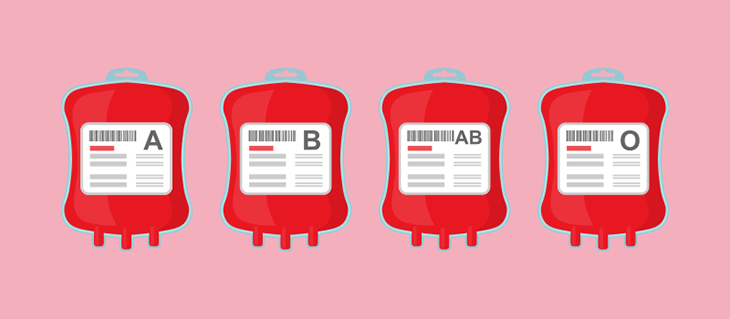
According to American Red Cross, “There are four major blood groups determined by the presence or absence of two antigens, A and B, on the surface of red blood cells.” And aside from the A and B antigens, there is also a protein known as Rh factor, which can also be present (+) or absent (-), which creates the 8 common blood types known as A+, A-, B+, B-, O+, O-, AB+, AB-.
According to a new meta-analysis that looked at more than 600,000 patients from 48 studies, a person’s blood type may also be linked to their possibility of having an early stroke.
Published in the August 31 journal Neurology, the findings include all the available data taken from genetic studies on ischemic strokes, which are strokes that are caused by a blockage of the blood flow to the brain in adults that were younger than 60 years old.
The Centers for Disease Control and Prevention (CDC), they share that for the overall population, this types of stroke is accountable for 87 percent of all strokes.
As for the study’s co-principal investigator and professor of neurology at the University of Maryland School of Medicine (UMSOM) in Baltimore, Steven J. Kittner, MD, MPH, he said in a press release, “The number of people with early strokes is rising. These people are more likely to die from the life-threatening event, and survivors potentially face decades with disability. Despite this, there is little research on the causes of early strokes.”
In fact, a paper that was published last February 2020 in the medical journal Stroke, there is an estimated 10 to 15 percent of strokes that occur in people below the age of 50.
Early Onset Stroke in People with Type A Blood Is More Likely Than Other Blood Types
To better look at the genetic factors that could possibly influence the risk of having a stroke, the research team analyzed 48 studies on genetics and ischemic stroke. This included 16,700 stroke patients and 599,237 healthy controls that had never experienced a stroke.
What they found was ‘a link between early-onset stroke, which means it occurs before the age of 60, and the area of the chromosome that includes the gene that determines whether a blood type is A, AB, B, or O.’
Through the study, the researchers also discovered that those who experienced an early stroke were more likely to be blood type A and less likely to be blood type O as compared to those with late stroke and those who never had a stroke.
For those who had both early and late strokes, they were also more likely to be blood type B than those in the healthy control group. The researchers also adjusted the study to account for sex and other factors, and what they found was that those with blood type A had ‘a 16 percent higher risk of early stroke than people with other blood types, and those who had blood type O had a 12 percent lower risk of stroke than people with other blood types.’
Notably, the authors also said that ‘the association of blood type with later-onset stroke was much weaker than blood type’s association with early stroke.’
Director of vascular neurology at NYU Langone Hospital in Brooklyn, New York, Brandon Giglio, MD, who was not part of the study said that it was very interesting. He said, “There’s been research to suggest there was also an association between blood type and other clotting disorders, like clots in the legs such as a deep vein thrombosis and of the pulmonary artery — a pulmonary embolism.”
Another study published in the January 2020 edition of American Heart Association journal, Arteriosclerosis, Thrombosis, and Vascular Biology compared people with type O blood to those with type A and B, and found that ‘the latter were 51 percent more likely to develop deep vein thrombosis and 47 percent more likely to develop a pulmonary embolism.’
Dr. Giglio said, “It’s interesting that this association extends to these types of clots, which are in arteries as opposed to those other clots which are in veins, though different mechanisms and processes cause strokes than those other types of clots.”
He also said that these findings suggest that there is a possible connection ‘between the patient’s blood type and the way their body promotes the formation of a clot.’
Blood Types
As explained earlier, blood types are determined by the presence or absence of particular antigens in the blood. These are substances that trigger an immune response to these so-called foreign invaders.
As explained by the American Red Cross:
- Type O blood (positive and negative) is the most common type of blood in the United States. About 45 percent of white people, 51 percent of Black people, 40 percent of Asians and 57 percent of Hispanics are type O.
- Type A blood is found in 40 percent of white people, 26 percent of Black people, 27.5 percent of Asians, and 31 percent of Hispanics.
- Type B blood is found in 11 percent of white people, 19 percent of Black people, 25.4 percent of Asians, and 10 percent of Hispanics.
- Type AB blood (meaning it has both A and B antigens) is the rarest type of blood and is found in 4 percent of white people, 3.3 percent of Black people, 7.1 percent of Asians, and 2.2 percent of Hispanics.
Extra Stroke Screening Due to Blood Type Not Necessary
What the researchers also stressed that because the increased risk is minimal, and that people with type A blood shouldn’t worry about having early-onset stroke or engage in extra screening or medical testing based on this new study.
Dr. Giglio also agreed, explaining, “With the information we have at present, I don’t think we have any interventions to modify risk based on the blood type.”
Ways to Reduce the Risk of Stroke
Regardless of blood type, there are ways to help lessen the risk of having a stroke.
The CDC recommends making these lifestyle choices in particular:
- Adopt a healthy diet that’s low in saturated fats, trans fat, and cholesterol and includes lots of fruits and vegetables.
- Maintain a healthy weight.
- Follow guidelines for physical activity and get at least 2 hours and 30 minutes of moderate-intensity exercise every week.
- Don’t smoke and limit alcohol.
- Pay attention to vascular risk factors such as cholesterol levels, blood pressure, and diabetes.
Study Findings May Help Prevent Strokes in Younger People
As per Dr. Kittner, “We clearly need more follow-up studies to clarify the mechanisms of increased stroke risk.”
However, the study authors also admit that the current study is still limited, due to a “relative lack of diversity among participants.”
Dr. Giglio added, “Future research may look to see if there are associations between blood types and risk factors for strokes.” He also shared that the possibility may actually lie in particular blood types putting people at risk for disease – like obesity or diabetes – rather than actually increasing the risk of stroke.



